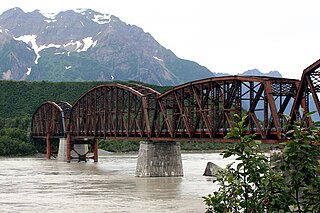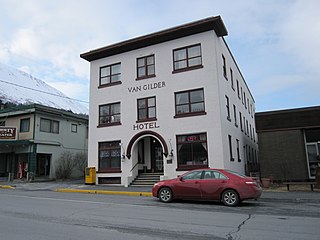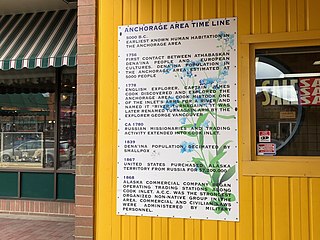
Seward is an incorporated home rule city in Alaska, United States. Located on Resurrection Bay, a fjord of the Gulf of Alaska on the Kenai Peninsula, Seward is situated on Alaska's southern coast, approximately 120 miles (190 km) by road from Alaska's largest city, Anchorage.

The 1964 Alaskan earthquake, also known as the Great Alaskan earthquake and Good Friday earthquake, occurred at 5:36 pm AKST on Good Friday, March 27. Across south-central Alaska, ground fissures, collapsing structures, and tsunamis resulting from the earthquake caused about 131 deaths.

The Miles Glacier Bridge, also known as the Million Dollar Bridge, was built in the early 1900s across the Copper River fifty miles from Cordova in what is now the U.S. state of Alaska. It is a multiple-span Pennsylvania truss bridge which completed a 196-mile (315 km) railroad line for the Copper River and Northwestern Railway, built by J. P. Morgan and the Guggenheim family to haul copper from the old mining town of Kennicott, now located within the Wrangell–St. Elias National Park and Preserve, to the port of Cordova. It earned its nickname because of its $1.4 million cost, well recouped by the about $200 million worth of copper ore which was shipped as a result of its construction.

The Alaska Railroad is a Class II railroad that operates freight and passenger trains in the state of Alaska. The railroad's mainline runs between Seward on the southern coast and Fairbanks, near the center of the state. It passes through Anchorage and Denali National Park, to which 17% of visitors travel by train.

The Seward Highway is a highway in the U.S. state of Alaska that extends 125 miles (201 km) from Seward to Anchorage. It was completed in 1951 and runs through the scenic Kenai Peninsula, Chugach National Forest, Turnagain Arm, and Kenai Mountains. The Seward Highway is numbered Alaska Route 9 (AK-9) for the first 37 miles (60 km) from Seward to the Sterling Highway and AK-1 for the remaining distance to Anchorage. At the junction with the Sterling Highway, AK-1 turns west towards Sterling and Homer. About eight miles (13 km) of the Seward Highway leading into Anchorage is built to freeway standards. In Anchorage, the Seward Highway terminates at an intersection with 5th Avenue, which AK-1 is routed to, and which then leads to the Glenn Highway freeway.

A. J. Dimond High School (DHS) is a public four-year high school in Anchorage, Alaska, and is a part of the Anchorage School District. It has been accredited by the Northwest Commission on Colleges and Universities. Dimond serves students in the Sand Lake, Kincaid, and Bayshore areas of suburban Anchorage, and had an enrollment of 1,709 as of November 25, 2016.

The Alaskan Hotel and Bar, also known as the Northlander Hotel and The Alaskan, is a historic establishment and the oldest operating hotel in Juneau, Alaska. It was opened in 1913. The owners, three miners who struck it rich in the nearby Coast Range, tied the hotel's keys to a helium balloon and released it, signifying that the hotel would never close. The building was briefly condemned in the 1970s, but was rehabilitated by the new owners.

Reed and Stem is an American architectural and engineering firm. The firm was founded in St. Paul, Minnesota in 1891 as a partnership between Charles A. Reed (1858–1911) and Allen H. Stem (1856–1931), the successful partnership captured a wide range of commissions. The firm was reformed as Wank Adams Slavin Associates in 1961, and adopted the name WASA Studio in 2004.

The following outline is provided as an overview of and topical guide to the U.S. state of Alaska:

Anchorage Depot, also known as Alaska Railroad Depot, is the railroad station at the center of the Alaska Railroad system at the junction of the two main lines their trains run on. It serves as the starting point for many tourists traveling on the luxury trains such as the Denali Star. The station is a Moderne-style three story concrete building, built in 1942 and enlarged in 1948.

The Van Gilder Hotel is a historic multipurpose commercial and civic building at 307 Adams Street in Seward, Alaska, United States.

The Seward Depot, also known as the Seward Station, is a former rail depot in Seward, Alaska, United States.

The Wasilla Depot was built in 1917 in Wasilla, Alaska. It was designed and built by the Alaska Engineering Commission, a federal agency charged with building Alaska's railways. The structure, located at the corner of Parks Highway and Main Street, was restored by the Lions Clubs and the Wasilla Chamber of Commerce.

The Alaska Engineering Commission Cottage No. 25 is a historic house at 345 West Third Avenue in Anchorage, Alaska. It is a two-story wood-frame structure, with a low-pitch gable roof that has wide overhanging eaves with exposed rafter tails. It was designed and built in 1917 by the Alaska Engineering Commission, a Federal agency charged with building railways in Alaska. It is one of the second set of such housing built by the commission, and is now owned by Anchorage Historic Properties.

The Alaska Engineering Commission Cottage No. 23, also known as DeLong Cottage, is an historic house at 618 Christensen Drive in Anchorage, Alaska. It is a 1+1⁄2-story wood-frame structure, with a gable roof and porch extending across its front. It was designed and built in 1916 by the Alaska Engineering Commission (A.E.C.), the federal government project to build the Alaska Railroad. Of the surviving cottages built by the commission, it is the least-altered and best-preserved.

The following is a timeline of the history of the city of Anchorage, Alaska, United States.

The Knik Site, also known as the Old Knik Townsite, is the location in Matanuska-Susitna Borough, Alaska that was once home to the largest settlement on Cook Inlet. The only surviving remnants of the community are a former log roadhouse, now a museum operated by the Wasilla-Knik Historical Society, and a log cabin. The Knik area had long been a meeting point of Native Alaskans, and in 1898 it became the principal community on Cook Inlet from which goods were shipped into the interior. In 1916 the Alaska Railroad reached the site of present-day Anchorage, bypassing Knik and leading to Anchorage's growth. When the railroad reached Wasilla, Knik lost all importance as a transshipment point, and its buildings were either abandoned or moved to one of the other communities. Knik is located about 13 miles (21 km) southwest of Wasilla.

The Harding Railroad Car is a historically significant Pullman railroad passenger car located at Pioneer Park in Fairbanks, Alaska. Also called Denali, and designated with equipment number X-336 by the Alaska Railroad, the car was one of three used to carry a delegation that included President Warren G. Harding in 1923 to the Mears Memorial Bridge for a ceremony marking completion of the railroad between Fairbanks and Seward. The car was purchased by the Alaska Railroad in 1923 from the Great Northern Railroad, and was used in its service until 1945. At the urging of the Fairbanks "igloo" (chapter) of the Pioneers of Alaska, the car was restored in 1959–60 and given to the city of Fairbanks. It was placed in Alaskaland in 1967, created to mark the centennial of the Alaska Purchase. It was used for some years as the park's visitor center.

Manley & Mayer was an American architectural firm in Alaska, and was the leading firm in Anchorage for several decades.



















